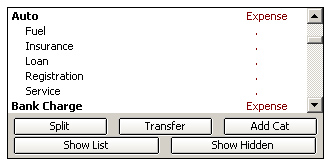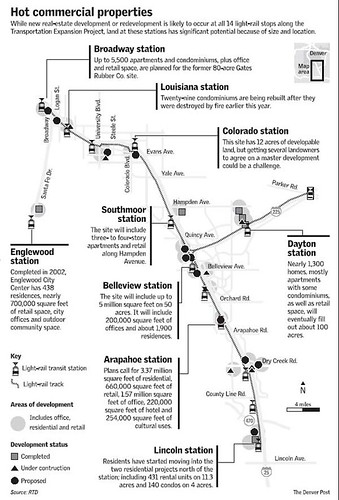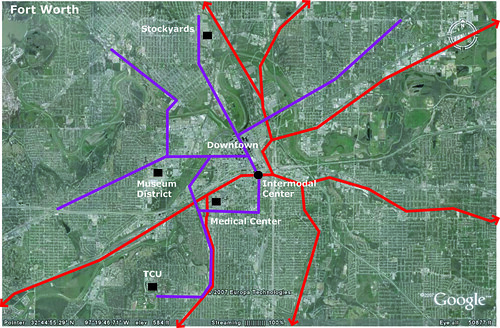Monday, July 9, 2007
Katy Freeway and Wasted Opportunities
It's might be better in the long run. Because we really don't want to have rail in the median of a freeway. It might be cheaper but I'm not sure its so great for urbanism given that the high speeds and winds generated from the freeway. It scares away pedestrians. Denver's line seems to be doing well. But I think if there was a subway through Orinda and Lafayette on BART, they would be much different places.
Sunday, July 8, 2007
Autocentricity in Consumerism

But what does this say about the overall consumer culture and our debt? Given that the median balance on the American credit card is $1,900, and 43% of Americans spend more than they earn, does this mean we are slaves to our cars?
According to this MSN Money article, the debt of America outside of our Mortgage is largely tied to non-revolving loans like the ones available for people to buy cars. That's just the capital cost for the car. Now what about operating the thing and roads? In 2005, the average American spends 18% of their income on transportation. Recent research suggests that this fluctuates between the exurbs and transit rich urban core with a difference of up to 16% between the extremes of 25% and 9% respectively.
In my own experience, I drive my car once a week and fill up the tank once a month. I probably wouldn't drive at all if my grandmother didn't live so far from BART. Otherwise I take Muni, BART, or walk. I would say that I'm around the 9% in transportation costs which allows me to pay a bit more in rent than I normally would be able to afford. But I'm also able to save up some money.
So in a consumer based, auto oriented society, we are largely tied to our cars, figuratively and sometimes literally. Over the last 60 years we've been so tied down that even personal finance software doesn't give us a transit choice but to enter it in ourselves. But as we've found out from parking, when given the choice for someone to unbundle, a lot of people will choose the alternative because there is one to choose. Someone gave an analogy recently, and forgive me for stealing it if you're reading but if there is a shelf full of only Pepsi how can you say that no one wanted to buy Coke? The choice wasn't there.
Friday, July 6, 2007
Denver Ridership

In their 2006 TOD Status Report, RTD-Denver, the local transit authority, reports that...
Some 3,704 residential units, 460,000 square feet of retail, and 300,000 square feet of office space have either been built or are currently under construction...An additional 3,713 residential units, 600 hotel rooms, 440,000 square feet of retail, 860,000 square feet of office space have been proposed. When added to projects at the I-25/Broadway transfer station, these 15 proposed projects have been an estimated value of approximately $1.7 billion.That's a good amount of TOD and I'm sure that some of the completed units have contributed to the elevated ridership.
Thursday, July 5, 2007
All About Oil
Wednesday, July 4, 2007
Happy 4th of July
Every time we walked out of my door I saw my car sitting on the curb and smiled. It's a great liberating feeling to know that I can get around without having to get in the car. I don't have to do the driving meaning i can chat with my sister about how good the movie is without worrying about hitting people while using hand gestures. We could walk to the grocery store and stop in shops along the way that sold wine, cheese, beer, shoes or whatever else. We could also listen to the little kids talking about Star Wars and Pokeman. It's pretty cool, I'm not gonna lie, I just wish everyone had the same options.
Feel Free to post your own transit-oriented Independence Day in the Comments.
Monday, July 2, 2007
Transit Network: Fort Worth

The Rapid Streetcar
Streetcars are cheaper because of their lower infrastructure requirements. Often there is no need to relocat utilities, right of way does not need to be purchased and the stops are smaller and the vehicles more pedestrian oriented. Streetcar stops are also closely spaced if the goal is to be a circulator or short line transport mode. However if a longer distance transit mode that mimics light rail is what you're looking for, but your city is on a budget, the rapid streetcar might be your choice.
Many cities have taken up the mantle of the rapid bus to be their cost effective alternative to light rail, but only do this based on cost, not because its what the citizenry wants. Recent Rapid Bus movements in Oakland, San Francisco, and Charlotte have shown that people really want light rail on a budget but haven't been able to engineer their systems to reduce costs and are therefore left with an inferior transit mode for their stated goals.
But by using streetcars in center lanes with single tracking and passing sidings at stations you can get the same performance as light rail on 10 minute headways. Streetcars aren't single vehicles either. Skoda streetcars have couplers on them as well that would make them multiple car consists. The lighter vehicles are about 66 feet long as opposed to 90 foot LRVs yet you can still get increased passenger capacity and lower infrastructure needs. You can see in the picture below from Skoda.

This fascinating development in value engineering is nothing new and has been rarely used in the United States if at all. A recent extension of the Portland Streetcar to Lake Oswego might be its first test. Literature on the subject has been presented at TRB by Lyndon Henry and has been extensively covered by Light Rail Now! Recent publications including Raise the Hammer in Canada as well as the folks in Kansas City have been looking to this option. This technology and engineering arrangement is a smart way for cities to get rapid transit and build the system they want and can afford, not the system they settle for.
Saturday, June 30, 2007
California High Speed Rail
Building a System: Portland's Legacy
21 years ago nothing was certain. However, the Portland region banded together to decide on their future. In 1986 Portland Tri-Met had 162,500 average weekday boardings, 19,600 on rail and the rest on bus. Fast forward to 2006, we see that 307,200 rides with 99,000 of those rides coming from rail. The May ridership for Portland was 110,000 average weekday boardings. What is important is that this rail push has saved gobs of cash. With a 72 cent required boost from Tri-Met versus a $1.92 for bus, you can see why the investment has paid off. 23% of Portland's operating cost is for rail yet rail makes up 32% of the ridership.
The vision of the original Lutraq plan and the network of rail lines and city centers is being quietly implemented all the time. Expected next week is an FFGA from the federal government for the I-205 Light Rail Line. Planning is underway for the Streetcar to Lake Oswego and Milwaukie Max. This plan shows that when cities put their will and collective mind into doing something it can get done. The expansion of Portland's system can be replicated but it takes time and planning. Hopefully more cities will wake up and realize the cost savings as well as quality of life improvements brought by this way of doing things.
Thursday, June 28, 2007
The Next Earthquake
A proposal to have 1:1 parking ratio in the city outside of downtown among other provisions. Just about the dumbest idea I've ever seen or heard of. Idiocy knows no bounds. Here are some other crazy provisions from a the comments...
The ordinance does NOT leave the recent C-3 (downtown) parking controls as is. In fact, it guts them. And it doesn't gut just the recent changes. It guts the fundamental controls that have existed in downtown for decades, and were the core of the City's renowned 1985 Downtown Plan, on which the Financial District we know today was built. The biggest change is not just the residential controls. The biggest, and most drastic change is the complete elimination of the limitation on commuter parking for commercial (office) buildings. The initiative would more allow (via changes to Section 151.1) more than 650% of the commuter parking currently allowed downtown! Where 100 spaces are now allowed, this initative would allow 667 spaces! This is a fact, and the math is simple:
The current controls place an absolute parking maximum equivalent to 7% of the gross floor area of an office building. 500,000 sf office = 35,000 sf parking = 100 parking spaces. Under the initative, a builder could build up to one space for every 750 square feet of office space. 500,000 sf office = 667 spaces. The words drastic and dramatic don't even begin to capture the magnitude of this change for downtown. The entire downtown has been built on a limited parking model, and only because of that reason (and only) the commute to downtown SF has the highest share of commuters taking transit outside of lower manhattan.
